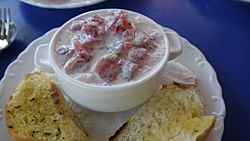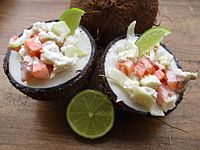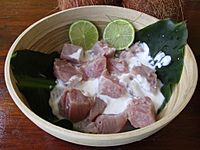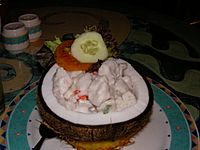'Ota 'ika facts for kids

ʻOta ʻika
|
|
| Alternative names | Coconut fish, Ika mata, Iʻa ota, Kokoda, Oka iʻa, Oraora, Ota, Poisson cru |
|---|---|
| Type | Salad |
| Course | Appetiser |
| Place of origin | Oceania |
| Region or state | American Samoa, Cook Islands, Fiji, French Polynesia, Kiribati, Nauru, New Zealand, Niue, Norfolk Island, Papua New Guinea, Pitcairn Islands, Samoa, Tokelau, Tonga, Tuvalu, Wallis and Futuna |
| Main ingredients | Fish, lemon, lime, coconut milk |
ʻOta ʻika is a Oceanian dish consisting of raw fish marinated in citrus juice and coconut milk. The Tongan, Tahitian, and Samoan variants are essentially identical in that the raw fish is briefly marinated in lemon or lime juice until the surface of the flesh becomes opaque. The fish is then mixed with coconut milk and diced vegetables (most commonly cucumber, tomato, onion, green onion, and spicy peppers). This is the national dish of Tonga.
Contents
Names
- Cook Islands: ika mata
- Fiji: kokoda
- French Polynesia: poisson cru, iʻa ota
- Nauru: coconut fish
- Niue: ʻota ʻika
- Samoa: oka iʻa
- Tokelau: ʻota ʻika
- Tonga: ʻota ʻika
- Tuvalu: ika mata
- Wallis and Futuna: ika ota
The dish is otherwise known as coconut fish in Nauru, kokoda in Fiji and Papua New Guinea, oka in Samoa, ika mata in the Cook Islands and New Zealand, oraora in Kiribati, and simply poisson cru on the French islands. The word "ota" means "raw" within the Polynesian language group, although the more common term for the dish in French Polynesia is its French equivalent, "poisson cru" (literally, "raw fish"). Any type of seafood can be used to make "ota," the word "ika" means fish ("i'a" in Samoan language), but the dish is often prepared with mussels ("ota pipi/maso"), prawns ("ota ulavai"), crab ("ota pa'a/paka"), lobster ("ota ula"), octopus/squid ("ota fe'e/feke"), sea urchin ("ota vana/tuitui"), and eel ("ota pusi").
Gallery
- Variants
Similar dishes
A very similar dish is the kinilaw of the Philippines, and its descendant dish, the kelaguen of the Marianas Islands. The poke of Hawaii is also similar though it does not use citrus juices or coconut milk. It is also similar to the Latin American ceviche, though the latter is relatively recent and may be a derivative dish, as citruses are not native to the Americas.
See also
 In Spanish: Pescado crudo polinesio para niños
In Spanish: Pescado crudo polinesio para niños




